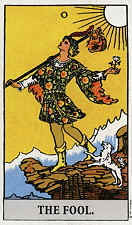
0.
The first card is the Fool. On
the first level of meaning, this represents the new group member, coming
to a group for the first time, looking for something new, perhaps some
higher aspiration. But the
Fool has not left everything behind.
The Fool carries a measuring rod which has been used before, and
which can be used again. And
the Fool carries a whole bag of other useful tools, ready to be used
again. For the Fool, the dog
is just the animal nature, to be left behind, while the gaze is directed
upwards. The clothes of the
Fool are fine, all buttoned up and belted: the pure white inner garment is
well hidden.
On
the second level of meaning, the Fool knows that the purpose is to step
off the existential edge, and that once that has been done, all the
equipment is irrelevant. But
the facilitator must never push the Fool over the edge – the task is to
lead the new group member to the existential edge, not to force the issue.
The Fool must find out the irrelevance of all the equipment – the
facilitator cannot do it. Actually
the facilitator can’t even bring the Fool to the existential edge,
because the Fool is already there. This
is the deepest card in the whole pack, and there will be more to be said
about it later.
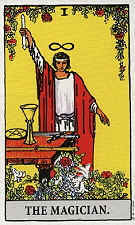
1.
The Magician is sometimes called the Juggler.
On the first level of meaning, this is the group facilitator as a
charismatic figure, who can manipulate all the tricks: the arousing of
emotions (cups); the separating of parts of the self (swords); the direct
body work (wands); and the use of tools and instruments (pentacles).
The red robe of passion and attachment to the material world can be
slipped on and off at will, because there is no belt on it.
The facilitator has great power and can use it at will, or so the
group members expect. A lot
of will and conscious control.
On
the second level of meaning, the magician is merely an instrument by which
power comes down from above to below.
The whole task is to be as empty as possible, so as not to stand in
the way of the power flow. The
less the facilitator does, the better.
The tools can then choose, rather than the facilitator choosing the
tools. Yet even at this level of meaning, there is a crazy optimism
about this card: this is the group facilitator as convinced about being
the instrument of some good effect, some important magic. And in this way it also represents the optimism of the group
member – that something is going to happen.
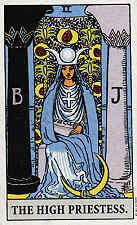
2.
The High Priestess is a guardian of secrets. On the first level of meaning, this is a reminder that the
facilitator is not going to get through to everyone. It is a reminder that there is plenty going on in the group
that the facilitator is not going to understand.
It is also a reminder not to
tell everything, but to know when to be silent. In this way it is also a card of balance and receptivity.
On
the second level of meaning, this is a card of utter desolation.
The facilitator must sometimes feel completely useless, unable to
help, unable to move. Everything
has become hidden, and all the penetrated secrets have gone back to being
secrets again. All the power,
the love, the tricks are of no avail now.
The facilitator is caught half way between the pillars of
affirmation and negation, and cannot move either way.
It is precisely at this point that the facilitator can
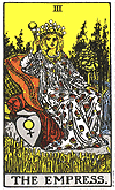
3.
The Empress is the warm mother-goddess.
She is the earth mother who enters into the ecology of nature –
human, animal, plant and mineral. She
reminds the facilitator to attend to the vegetative level, below the mind.
There is much going on that is nothing to do with words, nothing to
do with intellectual understanding. More
about feelings, sensations, the body.
On
the second level of meaning this card tells the facilitator that the
Empress is pregnant. A new
person is about to be born. The
facilitator must be prepared for this completely new personality to be
revealed – perhaps nothing like the Empress who gave birth to it.
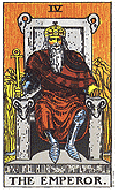
4.
The Emperor is the authority figure.
The facilitator is able to engineer structures, and get people to
carry out exercises. The
facilitator can control the way in which people interact, can lay down
group norms, can always remain
on top. This is the
facilitator as highly trained expert.
But
on the second level of meaning, this card is a reminder that the
facilitator is an arouser of resentment, an arouser of opposition, someone
who powerfully reminds group members of other authority figures they have
met in the past. The
facilitator needs to be aware of this all the time, and not be surprised
when it comes out.
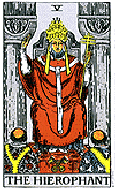
5. The Hierophant is the facilitator as teacher.
The facilitator communicates in words the theory behind the action. As long as this is short and relevant, the group members will
be quiet and receptive. This also
covers interpretations of what is going on in the group. Handouts may also be used in this role.
At the second level of meaning, this card shows that the facilitator is
also communicating through gestures, through looks, through tones of voice,
through symbols and through the role being played.
The facilitator cannot avoid being a teacher, even if words
are avoided altogether.
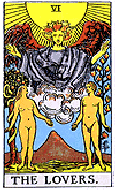
6. The Lovers is a card
about choice and conflict. The job
of the facilitator is to bring out the choices and the conflicts, and enable
them to be faced. Like a sword,
this work is to separate things which have been joined together in a confused
way, so that they can come together again in a more integrated way.
This is particularly so in couples workshops, where it is most important
to help people to be more upfront about their differences.
It also applies in organizational settings.
People are not just individuals. Everything
is brought out into the open, unveiled, nothing hidden.
And of course this card is also about love.
It is about the confrontation and also equally the support of the
facilitator.
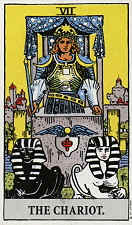
7. The Chariot is, on the
first level of meaning, the facilitator who unifies body, mind and emotions, and
enables them to run in harmony.
On the deeper level, it reminds the facilitator that the group is an
isolated vehicle of change, contained within artificial limits.
Everything happens within the finite time and place of the group’s
journey together. But all the
people in the group are going to have to get off at the end.
There is no way of staying permanently on the chariot.
So the facilitator must be sensitive to the group boundaries, and help
people to get off when the time comes, and the group comes to an end.
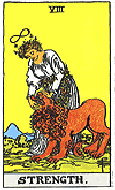
8. Strength is all about
breaking patterns of action. It
refers primarily to therapy on an individual level.
People have to know that they are not too weak and vulnerable to confront
what seem at first to be fierce and hostile forces inside themselves.
If confronted in the right way, the patterns will yield themselves up
without a struggle. This card is
all about the natural ability to digest and transform experience.
And going deeper, it also says that the confrontation of all past
experience also entails taking responsibility for it.
From now on, the lion will walk with the woman.
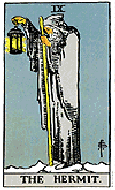
9. The Hermit is holding up a light, and showing travellers the way. This is the leader as helper or guide in unfamiliar territory, where we do not know the way. The facilitator is aware of what a tiny lamp it is, and how little light it sheds; but the group member is more aware of how useful it is. This is the facilitator as lonely and isolated, just hoping that what is on offer is going to be of some use. This is the facilitator at the most humble, and possibly most useful. It is just at the moment when the facilitator feels that the magic is not there, that the structures are not changeable, that the words do not help, that that same facilitator can be most human and most illuminating to the group member. The member can accept the light just because it does not seem to be identified too closely with the group facilitator.
The dangers here are: looking outside inside of looking inside; looking
to the group facilitator instead of inside, going from own experience; looking
to the group facilitator as the wise old man – heavy for the facilitator.
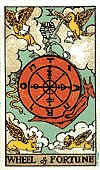
10. The Wheel of Fortune. At its simplest level, this is about luck, about the fact that not everything that happens in the group is intentional. The facilitator or the group member just strikes lucky.
At a second level, this is about time and change – there is a continual
flow and movement in the group,
which cannot be stopped or held back.
Change is not just change, but the way you experience something.
It is also about the cyclic nature of growth – we may often have to
work through the same thing again and again.
At a third level, this is about standing outside the group – that the
facilitator is in the group but not of it.
The facilitator can stop the world, by not being involved in the changes
taking place in the group. The
facilitator is observing, analysing, interpreting what is going on.
And at a fourth level, this is about finding the still centre at the hub
of the wheel, where the facilitator is registering all the changes, and
completely involved in them, but centred and unmoved by them.
At this level, the facilitator is not blocking the flow of the group, but
with it at every point.
This card is also a reminder of group rhythm.
At any point some concerns are becoming more important, and others less
important. The facilitator must be
aware of these rhythms and go with them.
Altoge
.
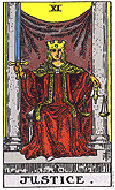
11. Justice.
This about a particularly difficult problem for the facilitator. By pushing someone (the Hebrew letter lamed, which goes with this card, represents an ox-goad) the
facilitator may reify a particular conflict or problem, and make it harder to
deal with. The sword may only
succeed in dividing so-called good from so-called evil, and creating magical
bodies which are false. But
ultimately it is not about dividing things and then balancing them – it is
about redemption, and the production of a personality which reflects completely
the true self. A big warning here,
which can also be put into other words – “Don’t try to pick green
apples!”
There is also something here about external standards versus internal
standards. We may have to cut into
the circles of our beliefs.
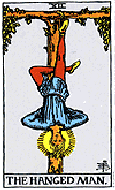
12. The Hanged Man.
First of all, this is about the kind of experiment one can do in a group.
One can reverse one’s way of life, and see what that feels like.
And once one has done this kind of reversal, and experienced one’s
reversed side, one is likely to be more accepting of other people.
So this is about wisdom as the result of experiencing one’s own
opposites and contradictions.
But it is also about self-surrender, happily giving oneself up to what
may seem to be death or punishment. See
the smile on the face. And this
applies to the facilitator too: it is about the moment when the facilitator
gives up being capable and efficient and technically sound and all those things,
and says instead – “Let it do
it!” This is a kind of self-emptying, when it does not seem to
matter about preserving or enhancing one’s ego, or whether one’s position is
dignified or undignified. Giving up
wilful consciousness.
It can also be a recommendation to prepare for the group by an act of
meditation.
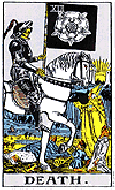
13. Death.
This is a card about sudden change.
Any change in a person’s ego or personality is resisted and feared,
because it seems like death. And
the more suddenly it happens, the more like death it seems.
So in any group gathered together for the purpose of change, catastrophic
expectations are in the air.
But the facilitator must have no compromise, no regard for convenience.
The facilitator’s confidence in the future is based on the view that no
force or law of the Universe is hostile to people, or an obstacle to people’s
freedom. So the facilitator does
not share in the catastrophic expectations of the group, but drives on
relentlessly.
This is the group facilitator as one who pushes, who provokes, who keeps
on when the person wants to stop, who drives, who is willing to exert power, and
involve emotions in a total commitment to change.
It may also be about misidentification.
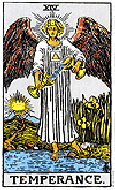
14. Temperance is a card
showing an angel with two jars, and not spilling a drop.
It shows how the group facilitator is continually going from one extreme
to another, without letting the energy level drop, without letting the thread be
lost. Opposites are continually
being poured one into the other. It
is also a card of balance, reminding the facilitator not to be too receptive or
too controlling.
This is a great test for the facilitator, and often the greatest feelings
of failure come here. The
facilitator feels that the energy has dropped, that the opposites have not been
combined, that the transitions have not been well managed.
This is a terrible testing time for the group facilitator – all the
tricks that worked before don’t work any more, and there seem to be no rules
left to go by.
But the card says that it is just at this moment that the facilitator can
trust to the spirit of the group to carry things off successfully.
The facilitator does not have to carry the full weight of responsibility
for what happens in the group. It
is the spirit of the group that has the wings, not the facilitator. The transformation of energies is always waiting ready.
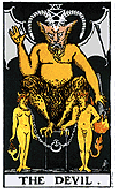
15. The Devil is a card that
reminds us of the limitations of the intellect.
The intellect continually tries to label things, but by so doing changes
them into illusions. This is about
the facilitator continually trying to understand things, and continually failing
if doing it by fitting a label on to a person or situation.
As soon as we call something evil, we have to treat it as bad and nothing more. But
there is always more to a situation than one label, one way of understanding it.
So the Devil is the facilitator as non-labeller, and discouraging anyone
in the group from reacting simply and solely in terms of labels.
It is also about the facilitator not letting the group members label her
or him, and not giving them any cause to do so.
At another level this card is about the contractual nature of the
relationship. The chains represent
agreements, some of them unconscious agreements.
There is a fear of what the group member may find.
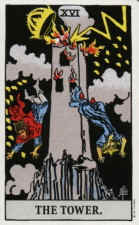
16. The Tower takes this one
stage further, and tells us that language itself is dangerous to a group.
Logic and language represent the certainties which we try to build up
into towers of strength – the strength of logic, the strength of past
experience. But the forces let
loose in the group produce the vortex in which language is confounded. Logic is hit by the helix of growth and life, and has to die.
There is a message about the chastisement of pride.
The group is the continual solution of the Zen koan,
and insight is sudden, like lightning. This
is the suddenly perceived necessity of moving away from formal logic into
dialectical thinking. Every moment
sees the overthrow of the facilitator’s existing way of life, and the
upsetting of existing notions. This
is the disruption which brings enlightenment.
Energy reaches the crown.
This is a hard card for the facilitator, because it speaks of the total
uselessness of every detail of their training and experience.
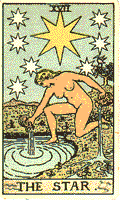
17. The Star is the card of
the Subtle self. Every man and every woman is a star. The facilitator can awaken the higher self of the group
member and link it to the central self. And
this is one of the most profound things the facilitator can do.
As someone once said – “When you have found the beginning of the Way,
the Star of your soul will show its light.”
This is one of the cards which speaks
of the facilitator’s real power in the group.
It is only insofar as the facilitator has contacted their own higher
powers that they are likely to enable others to do so.
But since this is in effect to be guided by the facilitator’s own
Subtle self, which involves surrender to that, this is not an ego trip for a
facilitator, but rather a humbling experience.
This is a card of unity and reconciliation, which is about meditation and
individual therapy as much as it is about groups.
At another level it is about the balance between emotional and
intellectual, body and spiritual.
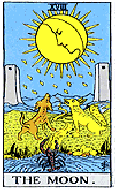
18. The Moon is the card of
the body, particularly the female body. The
body is as real and as important as anything else about the person.
But there is something harsh about this card – it is the body with no
artifice and no pretences. It is
what the Spanish call the duende –
dark sounds, harsh naturalness, something painful and real.
This is the facilitator as down to earth, in touch with reality, not
seduced by high drama, or attractive patterns of behaviour, or roles of any
kind. Facilitators have to trust
their lowest selves as much as their higher self, and using it all to be in
touch with all the parts of the group member.
There are times when the hands or feet or lips can say more than words.
But though these messages are powerful, they are not always clear.
They may need great understanding.
This is the card of the female imagination, coming ultimately from the
Great Goddess who always needs to be appreciated.
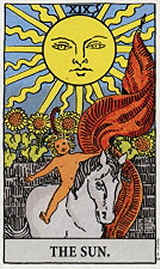
19. The Sun is also a card
of the body, but this time the male body. But
because it is the male body, it is denied in favour of the imagination.
Instead of perception there is enthusiasm; instead of reality, there is
fantasy; instead of comprehension there is every unsatisfied nameless desire.
There is a myth in some cultures that womankind is indigenous to earth,
while mankind came from other planets. So
whenever reason, technique, language, science are used to boost the ego rather
than to illuminate what is going on, this card is at work.
It is hard to deal with, because it always presents such a good face,
such a well-functioning stance, such a healthy way of working.
So the facilitator has to be very well centred to deal with this card.
The key thing to look for is idealization.
Whenever the facilitator hears such phrases as – “The group must
succeed”; or “We should be able to make this marriage work”; or “I
really believe in this method”, this card is probably present.
It is a hard card to deal with, because it involves putting down the
healthy male ego, or at least not taking it at face value, and our culture is
virtually dedicated to supporting and benefitting the healthy male ego.
And it may be particularly hard if the facilitator is prone to the
temptations of this card, and is using the group to be charismatic or brilliant.
There is a further message on another level for this card, however, which
shows how it can be used positively. It
says – “Go where the energy is”; and this means not being taken in by the
surface show, but noticing the members of the group who are showing discomfort,
or interest, or puzzlement, and bringing that energy to the surface and dealing
with it.
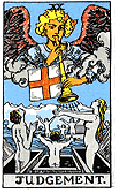
20. Judgement.
This is the card of Karma. It
tells the facilitator that there is no way of leaping out of the burden of past
history. Each person in the group
has their own background, their own pattern of past actions, their own set of
roles, built up over the years, and these are heavy limits on what can be
achieved in the group. The
implications of past existences have to be lived out and cannot be escaped.
Karma is a set of belief circles.
But there is a further meaning to this card, which is that the
facilitator can bring a person’s life to focus, so that it can all be placed
under the critical eye. This is a case of the facilitator getting his or her teeth
into a particular life, and looking at it in the light of long-term spiritual
principles. This is an
uncomfortable process, in which the group member can get upset and even
resentful. There is the possibility
here of seeing who one is, as a whole ongoing historical process, and this can
be wonderful. It can also be
frightening or threatening to the person who is unprepar
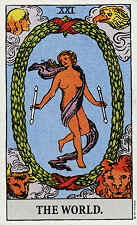
21. The World.
The first meaning of this card is that the world is too much with us. The world outside the group has set up hierarchical systems,
forms of slavery, which have affected us and limited us in a thousand
different ways. It has told us that
the only way to escape is to travel all over the world, to find new places and
new roles. But no matter how far we
go, a role is a role is a role is a role is a role.
The second meaning of this card is that the answer to these problems of
the world is to be found in Shiva the dancer.
The facilitator can lead the group to cosmic consciousness, but only by
surrendering to the dance. In
cosmic consciousness all sense of separate sex is lost, along with the
extinction of the sense of a separate personality.
This is a card of acceptance, a card of hope and justified optimism. But it emphasises that the whole thing in its entirely has to
change.
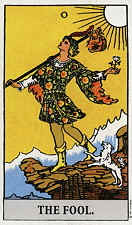
22. The Fool.
And so we return at last to the first card of all.
We can now see the deepest
meaning of the card – that the facilitator is completely empty-headed. The less the facilitator thinks, and the less the facilitator
offers, the more the group member has to work and learn.
If the facilitator can yield up to the dance movement of the group, and
contribute nothing, everything is being done that really needs to be done.
The facilitator is an absurdity, a joke, a paradox, a piece of
self-contradiction. The facilitator is most powerful when most invisible.
This is nothing to do with being passive, or not contributing anything.
The facilitator as Fool is contributing everything possible, fully and
completely, holding nothing back and giving nothing.
The facilitator as Fool is not helping, not guiding, not advising, not
initiating, not preventing, not hurrying up, not slowing down, not being wise,
not being stupid, not having favourites, not being impartial, not being a
parent, adult or child, not being a mother, a father or a sibling, not being a
leader, not being a person, not being a human being – and not being a
substitute or surrogate for any of these. The
facilitator is neither here nor there. This
is the easiest thing in the world for anyone to do – it only needs that one
live in the here and now – but it is apparently exceedingly rare.
